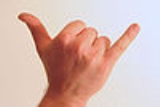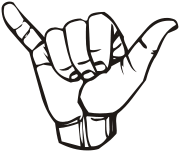
Shaka sign
Encyclopedia

Gesture
A gesture is a form of non-verbal communication in which visible bodily actions communicate particular messages, either in place of speech or together and in parallel with spoken words. Gestures include movement of the hands, face, or other parts of the body...
. It is often associated with Hawaii
Hawaii
Hawaii is the newest of the 50 U.S. states , and is the only U.S. state made up entirely of islands. It is the northernmost island group in Polynesia, occupying most of an archipelago in the central Pacific Ocean, southwest of the continental United States, southeast of Japan, and northeast of...
. It consists of extending the thumb and smallest finger while keeping the three middle fingers curled, and raising the hand as in salutation with the back of the hand facing the person that is being greeted; sometimes the hand is rotated back and forth to emphasize the sign.
The "shaka sign" has its roots in the Hawaiian custom of holding a lei (a necklace made of flowers) for the purpose of placement over the head on the shoulders of another in an Aloha greeting. The three middle fingers grasp the lei from over the top while the thumb and small finger rest under the lei thus spreading the 'necklace' open.
Meaning and use
Hawaiian locals use the shaka to convey what locals in Hawaii call the "AlohaAloha
Aloha in the Hawaiian language means affection, peace, compassion and mercy. Since the middle of the 19th century, it also has come to be used as an English greeting to say goodbye and hello...
Spirit", a gesture of friendship and understanding between the various ethnic cultures that reside within Hawaii, and thus it does not have a direct semantic to literal translation. Depending on context it can also be used to communicate notions such as "all right", "cool", "smooth", and the like.
Residents of states other than Hawaii who use the shaka may describe it as meaning "hang loose", and in Florida the symbol itself is more commonly called the "hang loose" sign rather than the shaka sign. It can also be used to signal "hello", "goodbye", "till next time", "take care" or "all right!". In sign language, the shaka is one of the two signs used to refer to surfing
Surfing
Surfing' is a surface water sport in which the surfer rides a surfboard on the crest and face of a wave which is carrying the surfer towards the shore...
.
Holding the shaka sign with the pinkie finger at the mouth and the thumb at the ear conveys a hand representation of a telephone.
Holding the shaka sign with the thumb at the mouth and the pinkie towards the sky with the head tilted back refers to drinking.
In the east coast of Brazil
Brazil
Brazil , officially the Federative Republic of Brazil , is the largest country in South America. It is the world's fifth largest country, both by geographical area and by population with over 192 million people...
, the shaka sign is known only as the "hang loose" sign and is one of the most popular gestures.
In the Caribbean, mostly in the Lesser Antilles Aruba, Bonaire & Curaçao it's used as a form of "sex" if used in the way of the thumb facing yourself and the pinkie facing in front and moving it towards the person and yourself.
In China this gesture also means "six".
Origin

Hamana Kalili
Hamana Kalili was a Hawaiian fisherman from the town of Laie. He is popularly credited as being the originator of the Shaka sign....
of Laie, who lost the three middle fingers of his right hand while working at the Kahuku Sugar Mill. Kalili was then shifted to guarding the sugar train, and his all-clear wave of thumb and pinkie is said to have evolved over the years into the shaka as children would imitate his unique hand "waaaave."
The shaka sign was popularized among locals in Hawaii through its use by second-hand car salesman Lippy Espinda in his television commercials, which were broadcast throughout the state in the 1960s. It was adopted as a salutation of friendship by the local culture at large from then on.
Another well-known and locally accepted version of the origin of the Shaka Sign is that of its first use by Alan Machado of the Island of Molokai. He was locally known as 'Baby Alan' Machado. John Noland of Makakilo, Oahu, Hawaii, tells the story of Baby Alan using the sign in such a manner as not used today. Unlike today's sign of holding up the hand and waving the fingers, Baby Alan would begin the shaka sign at about shoulder height fronting the body, and swing it down with a twist. Most locals would give the sign this way.

